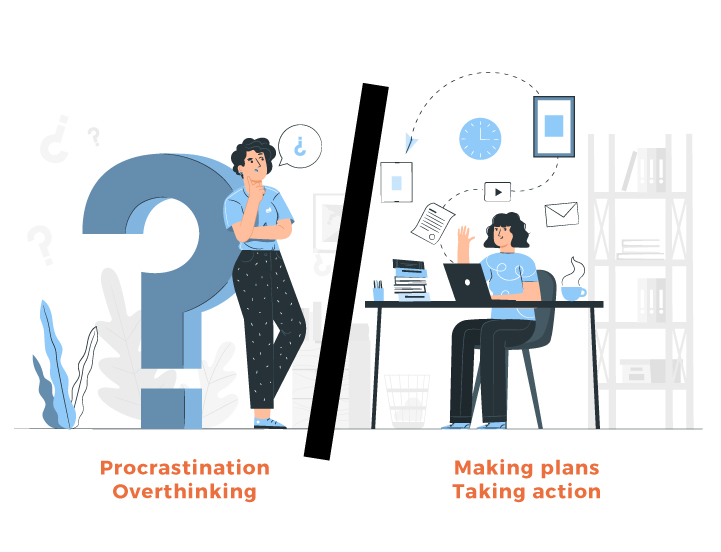Want to Start an Online Course Business? (9 Step How To!)

So here you are. Researching “how to create online courses,” and this pops up. Lucky you!
The world of teaching online courses is not easy to navigate. There is lots of info out there about what to do, how to do it, and what not to do. But we want to break it all down for you from start to finish - into tangible steps that you can take today.
This guide will walk you through the different steps involved in making an online course business and help you create a platform for your business that does more than just fill your pockets. You’ll learn how to build an online business that lets you share your valuable knowledge with the people who need it most.
A way to make the world better with what you already know.
If you’re ready to blaze the trail of selling a course online, then keep reading!
Table of Contents:
- Getting Your Mindset Right
- Figuring Out Your Course Topic
- Researching Your Topic and Competitors
- Surveying Your Potential Customers
- Setting Your Goals
- Creating the Course Content
- Selling the Course
- Sustaining Your Community
- Rinse and Repeat
- Conclusion
Getting Your Mindset Right
The first thing to consider is how ready you actually are to start an online business. Have you done this kind of thing before? Are you completely new to making money online?
No matter where you fall on the spectrum, you can do this.
But you have to eliminate any fear you may have of failing. Failures are simply opportunities to learn and grow. You can’t be held back by thinking that you can’t make this happen. It’s just not true - you can create an online course business that succeeds.

Don’t let procrastination in the form of “perfectionism” keep you from taking action either. Too often, we see people using the “perfectionist” mentality as a shield to keep themselves from having to do the hard work.
Your first course may not come out exactly as planned. Maybe you could have had a little better lighting. Maybe you could have spoken a little more clearly. Maybe you could have even sold more courses!
But if you don’t start, you don’t get any results.
Getting results means getting over any barriers you have in your mind about your ability or expertise on a topic. If you know more than the person you are teaching, you are the expert in that situation.
Matter of fact, you are even better positioned to teach people closer to your level than you are being a complete master and teaching newbies. If you are closer to the abilities of those you are teaching, you will relate more to their current situation and, in turn, be able to communicate to them better about the problems they are having now.
With all of that in mind, understand that you can do this. Believe it. You can teach something that people are dying to learn about and would even be willing to pay for. Don’t doubt your ability. Grow as you go and get your online course out there!
Figuring Out Your Course Topic
Now that you know you can create a profitable online course, what will you teach?
We’ll iron out the specifics in the next section when we dive into what’s already out there related to your general topic...
But for now...
What are you good at? What do you do for fun? What never feels like work to you that others admire your ability to do? These are all questions you should be asking yourself to figure out what your course should teach.

At Simplero, we have all kinds of coaches! From Life, Business, and Spiritual Coaches to Guitar Playing, Lacrosse Goalie-ing, and Parenting. You can see some examples on Simplero here!
Really the topic of your online course can be almost anything.
But no one else can figure out your course topic; this one’s on you. Some solid advice is to take your answer to one of those questions above and run with it.
If things don’t work out with that topic, you can always try again with another. Remember, failures are opportunities to learn.
Get your general topic written down somewhere and head to the next section to find out exactly what you should teach within that topic.
Researching Your Topic and Competitors
When you know your topic or at least have a topic idea, then it's time to find out what the other people teaching this subject online are covering.
The last thing you want to do is create a course that barely scratches the surface of your expertise or is just like another course that’s already out there.

What areas do other courses on the market drill down into the most about your topic? Are there gaps in the market for what you know about the topic? Can you present the info more concisely than your competitors?
Brainstorm these questions. Build a list of all the different valuable teachings you can bring to people through a course on your topic.
The basics won’t do, for success, you need to build your course on deep knowledge.

But you also can’t forget about the fundamentals. Take some time to brush up on them, and be aware of the basics your competition is covering. This way, you can deliver the essential basics and your unique insight.
But hold on just a second...
We still need to see if people will buy this thing!
Surveying Your Potential Customers
A common adage is to sell it before you build it. How do you do that?
Now would be the perfect time to start joining as many Subreddits, Facebook Groups, and Linkedin groups related to your topic as you can. Become friends with people in your space - the teachers and the students
See what problems potential customers are having and what they are asking questions about. How can you steer your course to fulfill their needs better based on what they are actually saying in their communities?
Straight up ask the groups if they would sign up for a course about your specific topic. Qualify your idea with field research that proves there is a market of buyers for the solution you have.
Use the communities that already exist surrounding your topic to fine-tune the contents of your online course site.

If you already have a following of any kind, poll them or run a survey to your list asking what exactly they need help with related to your topic.
Okay, but what if you don’t have an audience or a list yet?
Another great way to see what people are asking is through using Answer The Public to see what questions people are asking about your topic. Simply drop your topic into the search bar, and see what comes up.
You could also try the ole’ Google/Youtube suggestions route. Start to type in your topics and see what is auto-suggested. For example, try typing “marketing coach a,” “marketing coach b,” “marketing coach c,” etc. From there, you can go all the way through the alphabet and find out exactly what people are searching for.
Plus, whenever you search for a topic, you can head to the bottom of the search results on Google for more suggestions.
If you don’t have an audience or list, you’re probably wondering how you can start to build one. Don’t worry, we’ve got you covered in the “Selling Your Course” section below. ;)
Setting Your Goals
By this point, you should have a pretty good idea of some of the specifics you’ll be teaching in your online classes. That’s good, great even...
Now, what are your goals for your course site?

When I say goals here, I’m not just talking about how much money you want to make (even though that is a perfectly fine goal). I’m also talking about the journey you want to take your students on.
When I take your course and finish it, where will I be compared to where I was before I started?
This is something you want to clearly define because it will be a major part of your messaging and marketing. When you know who you are selling to, you need to be able to connect with them. You need to show potential customers that you understand where they are now and that you can get them to where they want to be.
Start your online course business so that it can be that bridge for your students. Get them to the goal with what you're teaching online.
In addition to the customer side of things, you will have your personal goals. How much do you want to make from your course, realistically? How many courses would you like to sell and at what price point to meet that number?
Do you want to build a cheaper beginner course to get lots of new people in, or are you teaching more advanced training? With the more advanced courses, you will have fewer people, but a higher price tag.
The point here is to understand how much you can make. You need to base your pricing on the number of sign-ups you believe you can get at the level of your particular course.
A good way to figure this out is to work backward. If you want to make $10k a month, then you need to make 10 sales at $997 a sale or a 100 sales at $97 a sale. Use this process with the dollar amount you want to make divided by how many sales you think you can make.
Goal setting is an important part of measuring your success and seeing you where you can improve next time.
Keep goal setting in mind when you are doing this prep work and use it as motivation to put your all into the content you are about to make.
Creating the Course Content
Perfect! We’ve made it to the juicy part of actually getting in front of a camera and sharing what you know.
This part can be a breeze if you’re regularly on video or are already the active face of your brand. If you’re new to this, then these tips will help you nail your online course creation.
First off, let’s start with the course outline. Before you turn on your camera and start going on about what you plan to teach, let’s organize the course.
You want your course to be in the most logical order to get the student from where they are now to the goal. While you outline your modules, keep in mind what it would be like if you were the student going through this course.
When you break down the topic into its different subjects, how can you give the student small wins per module? Teaching them something they can work with in each section rather than all of the info at once is a better approach.
Keep them winning. Show students what they are getting out of each module before you start the lesson. Make it clear what they will learn when they have completed each section. Keep this up through the entire course.
With your course organized and laid out, the next step is shooting and editing the videos.

If you don’t have a great webcam or fancy camera, an iPhone can do the trick. High-quality video isn’t super important (unless your course is about video quality!), but the content must always be high quality.
For editing, there are lots of options like iMovie or Adobe Premiere. If video editing isn’t something you want to tackle, you can always delegate the editing process to a freelancer on Fiverr and Upwork.
These sites are also great for getting designs for workbooks or any PDFs you might want to build as resources for your students. You don’t have to learn how to do everything that comes up. Sometimes it will make more sense to recruit the help you need to save time. Knowing when to delegate tasks will make the course creation much smoother.
After you have some videos recorded and edited, you need to host them somewhere so that your students can access them. Simplero is the perfect place for that. You can host your course site, build your landing pages, set up all your email automations, and more on our platform. (You can see a full list of Simplero's features here!)
With your online course platform and site built and your videos hosted, you’re all set to start selling!
Selling The Course
Having your online course business started means now you have to get students/customers into the thing.
There are lots of ways to get sales coming in, and I will cover a few below, but first thing first. You need a sales page for your potential customers to land on. This is where you will send everyone from any ads, emails, or other marketing efforts.
There are a few places you can build these landing pages online, but you might as well keep it simple and stick to the same platform, right?
This is another way Simplero can come in handy. You can duct-tape a few different online services together if you want, but if you want a simple platform with everything you need in one place, then Simplero is what you’re looking for.
In Simplero, you can fire up all the landing pages you want and even collect email addresses from them and contact your customers straight from the same platform. (Really, there is so much you can get done with your business all in one place with Simplero).
Start Your Free Simplero Trial!
After building your landing page, you’ll want to get it noticed. Here are a few ways to help you build your list and get more eyes on your sales page:
- Share With Groups and Followers:
Start by sharing your new course in all the groups you have joined from the research phase (if allowed by the group). By default, you could have some people signing up that liked your value adds in the different communities. Announcing your course launch to your current following is a no brainer, so don’t miss out on opportunities to get sign-ups there. - Run Some Facebook Ads:
Facebook Ads are a super popular option. This isn’t the place to go in-depth about how to run Facebook Ads, but here are some ideas of the types of ads you can run:
- Free Challenges: You can build out a free 5-day challenge where at the end of the 5 days, pitch your course. The challenge you run must connect to your course. Give students small wins that show them how to solve a problem they have while you identify a larger problem that your course solves.
- Contests/Giveaways: With these, you can ask participants to do something small to enter the contest. No matter what you choose to have participants do, make sure to collect their emails and give away something related to your course. This could be a piece of gear, one on one coaching, or anything related to your course that a potential student would enjoy. You can then reach out to everyone who provided their email and tell them that they are all winners and offer a discounted entry to your course or start nurturing them to pitch to later.
- Lead Magnets: Can one of your course PDFs work as a stand-alone value? Can you make some documents that would be valuable to potential customers related to your course? If so, give it away in exchange for an email address. This lets you build your list, and then you can send emails later to get sign-ups.
- Straight Ads to Your Course: You don’t necessarily have to use one of these tactics. You can just run ads to the course itself. Qualify the audience you are looking for. In the ad, include who the course is for, who it’s not for, and the problem it solves.
- Free Challenges: You can build out a free 5-day challenge where at the end of the 5 days, pitch your course. The challenge you run must connect to your course. Give students small wins that show them how to solve a problem they have while you identify a larger problem that your course solves.
- Use Your List:
If you have an existing email list, whether from the attempts mentioned above, or other sources, then you can get the word out about your course that way. Email blasts cost you nothing in ad spend, and you get the chance to make multiple announcements to really get in those extra touchpoints. (Don’t forget that you can also use your email list as a custom audience in Facebook Ads to make sure they see your ads as well as your emails!) - Collaborate:
Next up, I would suggest trying guest posts, podcasts appearances, and joint webinars with community leaders in your niche to get the word out there. You can also try adding value in forums or on Quora to point people towards your site or course that solves their problem. - Start Your Own Podcast or Webinar:
I mentioned getting on podcasts or webinars as a guest, but you can also start your own podcast or webinar related to your niche. Using the Facebook Ad tips above, you can get sign-ups or listeners to these too!

There are plenty of ways to get more sales to your course, but that should give you a good idea of how to start selling your online courses.
Sustaining Your Community
As you make sales and your course starts gaining traction, you’re going to feel great, but you don’t want the journey to end there.
Foster a community. Give your students a place to hang out online with other students and people interested in the same topics. Start a Facebook Page and Facebook group.
A Facebook group is a great tool for communicating with your audience and giving them all a forum to discuss the topics of your course content. Facebook groups don’t have to be as specific as your course. With a group based on a broader topic, you can attract new people that aren’t your students (yet).
Facebook groups and fostering a community can help you get sales from new people in your audience and give you another place to promote future courses. (No one said you can only teach one class online to your followers!)
Being engaged in your group is an excellent method for building authority in your niche and showing more of the world what you can offer. Don’t be afraid to go live in the Facebook groups to answer questions and just hang out with your followers.
Show them you are a human that is here for them, and they will be more inclined to follow along for your next course.
Speaking of your next course...
Rinse and Repeat
Having a successful course running and an engaged community to communicate with is only the beginning of what you can do through teaching online courses.
You can make more courses! Now that you have your first one out there, what else does your community want to learn? Really, ask them!
Keep filling in gaps for your followers, and they will become loyal fans. Some will buy anything you put out because they trust you and see you as a leader in your niche. If you show your students how to get from point A to B, they’ll count on you to go from point B to C, and so on.
As you follow these steps more and more, you will create better systems for creating and selling courses and become more adapted to what works specifically for you. These steps are general enough to get any course creator started, but how can you refine the process for what works best for your niche and audience?
Keep experimenting and find your success in the online course builder world!

Conclusion
I know, I know…
That’s a lot to take in!
You don’t have to execute on all of this in one day. We all learn at different speeds and in different ways. Go at your own pace. But don't forget that you CAN do this.
You have a course inside of you and people are waiting to learn what you have to teach!
Creating and running a successful online course business can be one of the most rewarding things you ever do, but you’ll never know the feeling if you don’t get started.
Don’t get overwhelmed with all of the info and tools out there. Just get started and see where it takes you. Find the best way to sell courses online that works for you and get to work.
Remember, the right platform can make a huge difference. So I want to offer you a free Simplero trial. This online course platform makes the tech simple so you can focus on doing more of what you love.
(Here’s a real pro-tip with your Simplero trial too. It is a 14-Day free trial, but if you do all of the pre-work and get your videos recorded and ready to upload, then you could be making your first sales before the trial even ends! Just imagine your course paying for the tech and platform before the first payment is even due. I challenge you to try!)
And remember, you’re not alone.
If you have any questions about launching your course, feel free to shoot an email to me over at michael@simplero.com. I’ll see what I can do to best help you on your path towards being a successful online coaching business owner!
Oh! ...
One more thing before you go! We have turned this whole blog into a checklist for you to use when creating your next course. Hope it can be of some help =)
How To Create A Course
Download Simplero's Course Creation Checklist
How To Create A Course










0 comments
Leave a comment
Please log in or register to post a comment